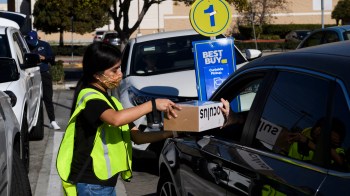Meet the woman who brought you the Tupperware Party
I’m not even in Wanda Clay’s house four minutes before she starts pulling out stuff to show me, such as a microwavable pressure cooker that she says can cook “whatever you want to cook in it.”
She calls herself the “Tupperware Lady,” and has been selling it for 43 years. She reveals the perks she’s received for selling Tupperware: trips to Hawaii and Paris, a piano, a grandfather clock. In 1971, she got her first car through Tupperware sales, a light-blue Ford Torino. “I’ve never had a car payment since,” Clay says, “and they do everything except put the gas in and change the oil.”
Clay is an example of the kind of woman Tupperware recruited — and still does — to sell its product: A wife and mother who wants to earn money without sacrificing the home life. Pushing for that plan was a woman who became the face of Tupperware starting in the 1950s: Brownie Wise.
“Brownie Wise was not a Harvard MBA,” says Bob Kealing, author of the book “Tupperware Unsealed: Brownie Wise, Earl Tupper, and the Home Party Pioneers.” “She was a single divorced mother of a young son. So she came from very very humble beginnings,” he says.
Wise didn’t invent Tupperware – that honor belongs to Earl Tupper, who “created a product that he based off of a paint can and a paint-can lid that had that airtight seal,” Kealing says.
Tupper tried selling these airtight containers at stores, but people didn’t understand how to use them so it didn’t go well, Kealing says. “That’s why Wise and some of her confederates figured out that it was the ideal home-demonstration product, so you could show people,” he says.
And that’s when sales took off.
Tupperware’s success came down to two things: It was a revolutionary product for the time that saved money (by effectively preserving leftovers), and the party concept also brought women together to talk and eat. “So it was much larger than just a sales technique,” Kealing says. “It became a social phenomenon. That was a key to her success.”
These parties were how Wise helped bring Tupperware into thousands of homes, Kealing says.
Wise soon moved into a lakeside mansion in Florida, and people knew her by her first name the same way people know Beyoncé. But Tupper feared that Wise was letting her name get bigger than the brand. “And then Earl Tupper fired her, kicked her out of the house, which she did not own,” he says.
Months later, Tupper sold the company for $16 million. Wise walked away with $35,000 in severance, Kealing says, and pretty much faded into obscurity.
Still, she helped pave the way for home-party sales systems that came later, like Mary Kay and Pampered Chef.
Two nights after we meet, Clay is having a Tupperware party of her own at one woman’s house. Clay is making salsa, throwing together a taco salad, making a refried bean casserole. She shows off a food chopper that’s also a salad spinner and makes ice cream and smoothies. It’s like watching a live infomercial.
Jean McNew, who dropped $71 at a Tupperware party last week, is buying more stuff at her daughter’s party. “I’m getting the cereal bowls, and I’m getting the mini-party set for a friend of mine for Christmas,” she says.
It will be a decent night for Clay. She will sell more than $500 worth of merchandise and take home at least 35 percent of that.
And she just ordered her newest car — a 2015 Buick Enclave, courtesy of Tupperware.
There’s a lot happening in the world. Through it all, Marketplace is here for you.
You rely on Marketplace to break down the world’s events and tell you how it affects you in a fact-based, approachable way. We rely on your financial support to keep making that possible.
Your donation today powers the independent journalism that you rely on. For just $5/month, you can help sustain Marketplace so we can keep reporting on the things that matter to you.


















